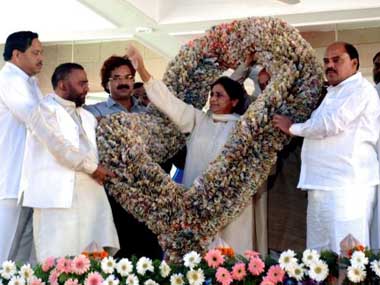We’ve heard of rainbow coalitions and social engineering alongside the clamour for reservations for various caste groups. Every pre-poll season is dominated by complex mathematics of the OBC, the EBCs (the extremely backward castes), their influence as a percentage of population calculated to the last decimal point. It’s safe to assume that from regional parties to the national parties, no organisation leaves the caste factor out of calculations in the run-up to an election. [caption id=“attachment_236354” align=“alignleft” width=“380”]  Mayawati cannot really count on a caste group’s votes. AFP[/caption] But sociologist Dipankar Gupta, writing in The Hindu, contends that most people are actually left with no choice but to vote outside their caste. Gupta argues that in most constituencies, there are five or six caste groups with roughly the same kind of numerical strength. With the exception of the Marathas who form about one third the voting population in Maharashtra, everywhere else, the so-called dominant caste accounts for only 20 to 25 percent of the voter base – just 10 percent of the population of Western Uttar Pradesh is Jat, he points out, though the region is called a Jat stronghold. Madhopura in Bihar may be a Yadav stronghold, but no more than 23 to 25 percent here belong to the Yadav caste group. Assuming that all caste groups exercise their franchise more or less equally, the caste factor is questioned in several outcomes, he points out. So, despite the large Maratha percentage in South Mumbai, the seat was won for two consecutive terms by Milind Deora, a Gujarati. The Marathas are also a large constituent of the electorate in Mumbai South Central, won by the Punjabi Priya Dutt. He offers plenty of examples: The BSP lost every seat in 2002 in parts of Eastern UP where the SCs are dominant. In 2007, the same seats voted in favour of Mayawati. The reason, says Gupta, is that while there are five or six major caste groups in a constituency, only two candidates are the major contenders. Unwilling to waste a vote, many voters would thus vote outside their caste group, “for someone they would not have tea with”. “Unsurprisingly, when psephologists and politicians use caste numbers to predict election results, they are almost always wrong,” he writes. The other apparent reason is that there is an “urban bias” that leads people to believe that all groups within the SC/ST/OBC groupings think and behave uniformly. The complexities of the intra-group cleavages, the smaller sub-sections within the group would make accurate caste-based voting behaviour predictions near-impossible. How does this impact Lok Sabha Election 2014? Perhaps this will matter more in Uttar Pradesh and Bihar than anywhere else, where regional satraps are pinning their hopes on their finely-tuned caste predictions and caste-based selection of candidates. During a debate on CNN-IBN earlier this month , historian and author Ramchandra Guha had said that, for example, Lalu won’t be able to count on the Yadav vote any more, at least not like he could once. Gupta had said people are unable to vote on their caste grounds any more. Needless to say, the biggest beneficiary of this would be the BJP. Prof Sandeep Shastri of Lokniti Network had said then that a significant chunk of lower caste votes have also actually moved towards the BJP. The Jatav vote, for example, moved from the BSP to the BJP, Shastri said. That means caste-based voting behaviour is simply no longer predictable. As Gupta writes, this is perhaps why many of them “are now talking about development instead”.
Dipankar Gupta has argued that with four or five major caste groups in every constituency but only two major contenders, most people are forced to vote outside their caste.
Advertisement
End of Article


)
)
)
)
)
)
)
)
)



